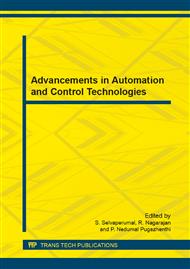[1]
Arash Roomizadeh, Sina Mohseni , Mehdi Niroomand, 2011, Study on Periodic and non Periodic Frequency Modulation Techniques for EMI Suppression in SMPS, 2nd Power Electronics, Drive Systems and Technologies Conference, pp.615-619.
DOI: 10.1109/pedstc.2011.5742493
Google Scholar
[2]
Basil M. Saied , Shefa A. Dawwd, Ahmad S. Al-Soufi, February 2010, FPGA based Selective Harmonic Elimination Pulse Width Modulation Technique, 4th International Design and Test Workshop (IDT), pp.1-6.
DOI: 10.1109/idt.2009.5404137
Google Scholar
[3]
C. R. Paul, 2006, Introduction to Electromagnetic Compatibility, John Wiley & Sons, 2nd edition.
Google Scholar
[4]
Chulwoo Kim and Minyoung Song et al, 2010, A cost-effective design of spread spectrum clock generator, 10th IEEE International Conference on Solid-State and Integrated Circuit Technology (ICSICT), p.159 – 162.
DOI: 10.1109/icsict.2010.5667815
Google Scholar
[5]
EN 55025 Document, Radio disturbance characteristics for protection of receivers used on board vehicles, boats, and on devices — Limits and methods of measurements.
DOI: 10.3403/02771447
Google Scholar
[6]
Franc Mihaliˇc and Dejan Kos, Randomized PWM for conductive EMI reduction in DC-DC choppers, , HAIT Journal of Science and Engineering B, Volume 2, Issues 5-6, pp.594-608.
Google Scholar
[7]
Gamal M. Dousoky, Masahito Shoyama, Tamotsu Ninomiya, July 2010, On Factors Affecting EMI – Performance of Conducted-Noise-Mitigating Digital Controllers in DC-DC Converters—An Experimental Investigation, IEEE Transactions in Industrial Electronics, Vol. 56, No. 7, pp.1239-1245.
DOI: 10.1109/ecce.2010.5617822
Google Scholar
[8]
Gray and Meyer, 2005, Analysis and Design of Analog Integrated Circuits, Wiley International.
Google Scholar
[9]
Guidance for User of CISPR Standards. http: /www. iec. ch/emc/pdf/cispr_guide_2010. pdf.
Google Scholar
[10]
G. Setti, R. Rovatti, S. Callegari & A. Bellini, 2010, Chaos-Based Generation of Low-EMI PWM Control Signals for Induction Motor Drives, IEICE Transactions on Electronics Vol. E87-C, No. 1, pp.66-75.
DOI: 10.1109/iecon.2001.976018
Google Scholar
[11]
Haishi Wang et al, 2010, Application of Spread Spectrum for EMI Reduction in Class D Amplifier, 10th IEEE International Conference on Solid-State and Integrated Circuit Technology (ICSICT), p.129 – 131.
DOI: 10.1109/icsict.2010.5667827
Google Scholar
[12]
Elenora Darie, Costin Cepsia, Emanual Darie, Modeling EMI Problems Associated with DC-DC Converters, 2nd International Conference on Modern Power Systems MPS 2008, 12-14 Nov. 2008, Romania, pp.281-284.
Google Scholar
[13]
Tamilarasu. S, P. Thirunavukkarasu and Sethupathi, EMI Generated by switched DC – DC Convertes in Automotive Applications, International Journal of Current Engineering and Technolgy, ISSN 2277–4106, 2013, pp.1220-1224.
Google Scholar


